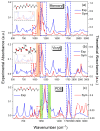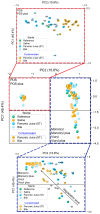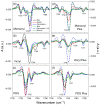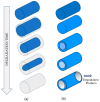The Degradation of Absorbable Surgical Threads in Body Fluids: Insights from Infrared Spectroscopy Studies
- PMID: 39457115
- PMCID: PMC11508208
- DOI: 10.3390/ijms252011333
The Degradation of Absorbable Surgical Threads in Body Fluids: Insights from Infrared Spectroscopy Studies
Abstract
This study investigates the degradation of six different types of absorbable surgical threads commonly used in clinical practice, focusing on their response to exposure to physiological fluids. The threads were subjected to hydrolytic and enzymatic degradation in physiological saline, bile, and pancreatic juice. Our findings demonstrate that bile and pancreatic juice, particularly when contaminated with bacterial strains such as Escherichia coli, Klebsiella spp., and Enterococcus faecalis, significantly accelerate the degradation process. Using Fourier-transform infrared spectroscopy (FTIR), scanning electron microscopy (SEM), and tensile strength testing, we observed distinct differences in the chemical structure and mechanical integrity of the sutures. Principal component analysis (PCA) of the FTIR spectra revealed that PDS threads exhibited the highest resistance to degradation, maintaining their mechanical properties for a longer duration compared with Monocryl and Vicryl. These results highlight the critical role of thread selection in gastrointestinal surgeries, where prolonged exposure to bile and pancreatic juice can compromise the suture integrity and lead to postoperative complications. The insights gained from this study will contribute to improving the selection and application of absorbable threads in clinical settings.
Keywords: FTIR; Monocryl Plus; PCA analysis; PDS; PDS Plus; SEM; Vicryl; Vicryl Plus; hydrolytic degradation; poliglactin-910; poliglecaprone 25; polydioxanone; surgical threads; tensile strength; triclosan.
Conflict of interest statement
The authors declare no conflicts of interest.
Figures












References
-
- Adanur S. Wellington Sears Handbook of Industrial Textiles. 1st ed. CRC Press; Boca Raton, FL, USA: 1995. 832p
MeSH terms
LinkOut - more resources
Full Text Sources
Miscellaneous

